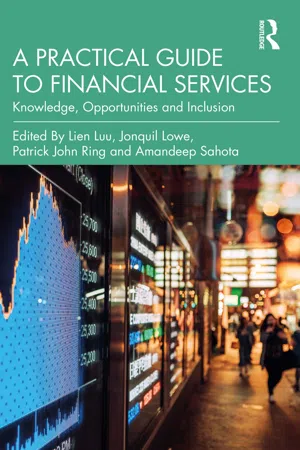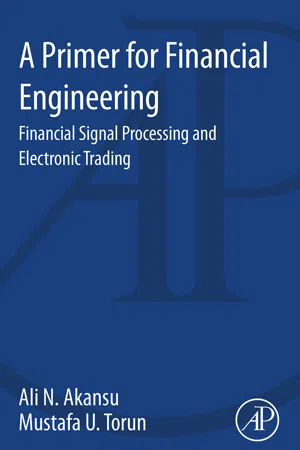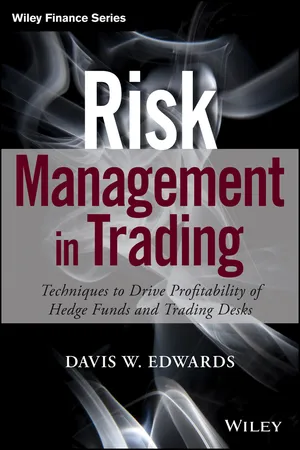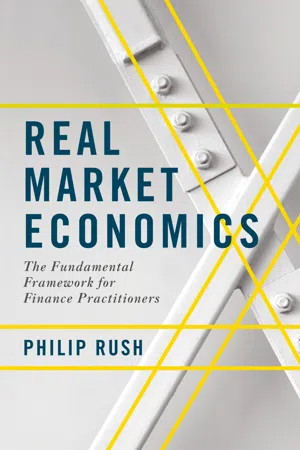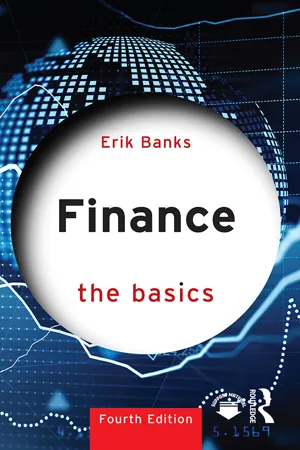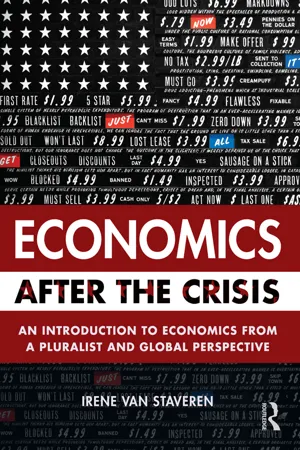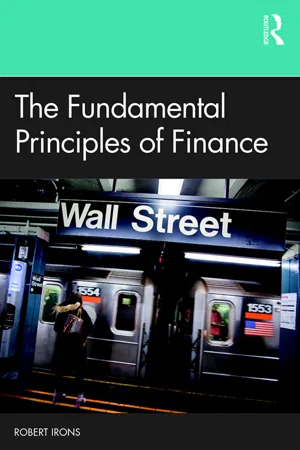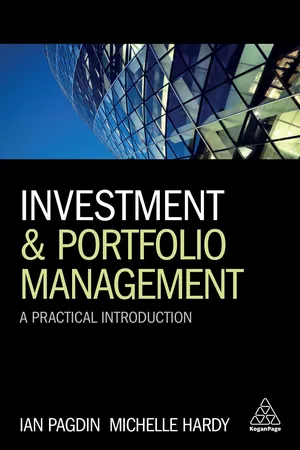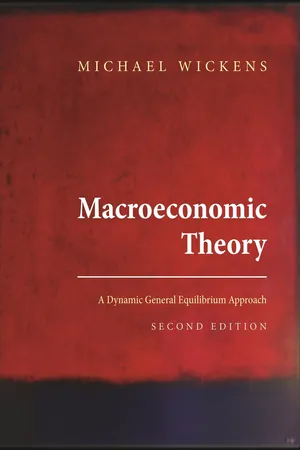Economics
Financial Markets and Instruments
Financial markets are platforms where individuals and institutions trade financial securities, such as stocks, bonds, and derivatives. These markets facilitate the flow of capital between investors and borrowers, allowing for efficient allocation of resources. Financial instruments are the tradable assets that represent a claim on future cash flows or ownership rights, and they are used by investors to achieve their financial objectives.
Written by Perlego with AI-assistance
Related key terms
11 Key excerpts on "Financial Markets and Instruments"
- eBook - ePub
A Practical Guide to Financial Services
Knowledge, Opportunities and Inclusion
- Lien Luu, Jonquil Lowe, Patrick Ring, Amandeep Sahota, Lien Luu, Jonquil Lowe, Patrick Ring, Amandeep Sahota(Authors)
- 2021(Publication Date)
- Routledge(Publisher)
2 Financial markets Amandeep SahotaDOI: 10.4324/9781003227663-2Key points summary- Financial markets are marketplaces where financial securities such as equities, bonds, futures and options are traded.
- Companies and governments use financial markets for many reasons, such as raising capital, hedging risk and managing the economy.
- Both large and small investors participate in financial markets to take advantage of variety of investment opportunities and access the potential to earn higher returns than available on cash savings.
Financial markets are the venues – typically dematerialised – where participants can shift resources and risk from one to another and/or from one point in time to another. The reasons for doing so may pertain to providing liquidity and finance for ongoing business, funding new investment, managing risks or simply generating profit from the markets themselves. Transactions involves buying or selling financial securities such as equities , bonds and derivatives.As Figure 2.1 demonstrates, financial markets are huge ‒ collectively dwarfing the value of global GDP which was estimated to be $88 trillion in 2019 (World Bank, 2021 ). Financial markets may seem exotic and remote from the everyday life of the average consumer, with only a minority engaging in them directly. However, while it is true that the majority of direct participants are typically institutions, like banks, and professional traders, the retail products that consumers use – including debt products, insurance contracts, pension schemes and other savings and investments – are all underpinned by these vast, global markets (Valdez and Molyneux, 2016 - eBook - ePub
A Primer for Financial Engineering
Financial Signal Processing and Electronic Trading
- Ali N. Akansu, Mustafa U. Torun(Authors)
- 2015(Publication Date)
- Academic Press(Publisher)
Chapter 2Financial Markets and Instruments
Abstract
We start with the definitions and descriptions of different entities in the financial markets and how they interact with each other. We introduce exchanges, electronic communication networks (ECNs), broker-dealers, market-makers, regulators, traders, and funds to better understand the financial ecosystem given that the legal framework, regulatory and compliance issues are beyond the scope of this book. In a separate section, we delve into the details of various types of financial instruments, i.e., stocks, options, futures, exchange traded funds (ETFs), currency pairs, and fixed income securities. Our goal in this chapter is not to provide the exhaustive details of these entities, instruments, and their relationships with each other. We rather aim to equip engineers with a good understanding of these concepts to navigate further in the area they choose to focus on through the references provided. We note that our primary focus is the financial markets and products offered in the United States. However, with only slight nuances, the concepts and definitions are globally applicable to any local financial market of interest.Keywords Stocks Options Futures contracts Exchange traded funds Currency pairs2.1Structure of the Markets82.2Financial Instruments122.3Summary21We start with the definitions and descriptions of different entities in the financial markets and how they interact with each other. We introduce exchanges, electronic communication networks (ECNs), broker-dealers, market-makers, regulators, traders, and funds to better understand the financial ecosystem given that the legal framework, regulatory and compliance issues are beyond the scope of this book. In a separate section, we delve into the details of various types of financial instruments, i.e., stocks, options, futures, exchange traded funds (ETFs), currency pairs, and fixed income securities. Our goal in this chapter is not to provide the exhaustive details of these entities, instruments, and their relationships with each other. We rather aim to equip engineers with a good understanding of these concepts to navigate further in the area they choose to focus on through the references provided. We note that our primary focus is the financial markets and products offered in the United States. However, with only slight nuances, the concepts and definitions are globally applicable to any local financial market of interest. - eBook - ePub
Risk Management in Trading
Techniques to Drive Profitability of Hedge Funds and Trading Desks
- Davis Edwards(Author)
- 2014(Publication Date)
- Wiley(Publisher)
CHAPTER 2 Financial MarketsThis chapter introduces many commonly traded financial products like stocks, bonds, futures, and options. These products are broadly grouped into real assets, financial assets, and derivatives. Then, these broad product types are further broken down to describe some unique features of the individual products that make up that general category.FINANCIAL INSTRUMENTS
Traders, whether individual traders or institutional traders like hedge funds, are in the business of buying and selling special types of contracts, called financial instruments. Financial instrument is a general term that refers to any type of tradable financial contract. Another term for financial instrument is security, as in securities markets. Originally, securities referred to instruments that provided an ownership right like stocks and bonds. However, in many jurisdictions, the term security now includes financial instruments that derive their value from commodities and from other financial instruments (derivatives).The three main types of financial instruments are real assets, financial assets, and derivatives. Real assets include physical commodities (like gold, oil, corn, or cattle), real estate, and legislatively created rights (like carbon emissions rights). Financial assets are primarily composed of contracts that give an ownership interest in a company (stocks), borrowing (bonds), or currencies. Derivatives are financial contracts that derive their value from other financial instruments. For example, a derivative might be an agreement to buy a physical commodity at some point in the future (a futures contract) or a contract that gives its owner the right, but not the obligation, to purchase stock in a company (a stock option). (See Table 2.1 - eBook - ePub
Real Market Economics
The Fundamental Framework for Finance Practitioners
- Philip Rush(Author)
- 2017(Publication Date)
- Palgrave Macmillan(Publisher)
While policymakers aim to improve outcomes, it is not always possible or desirable to interact with the real economy directly. So for monetary policy, in particular, financial markets are often used as the vehicle of choice. Details of capital movements are typically still deferred to market participants, who will ultimately profit from them. Doing so should aid the allocative efficiency of capital, at least in an economic sense, although the extent is subject to much ideological debate, as revealed through often widely different policy interventions. It is the profit motive that nonetheless ultimately drives a successful investor’s response, whatever the source or sense of the shock. And it is the underlying economics that determines where prices should fundamentally find fair value. Not all of those economic factors may originate from the macroeconomy though. In fact, some of the most interesting will be emergent from the rational self-interest of many individuals. Market structure has a significant effect on the sometimes non-linear or even chaotic outcomes here. With regulatory changes turning structures on their head, it is now especially important to understand how this interacts with the real economy to drive movements in real markets.This part begins with the plumbing of the financial system, which might at first seem too far away from the sexy trading topics you’re ready to read here. However, this stuff is essential to market functioning. Understanding what money is, how it is created and how it interacts with capital underlie everything. Having got to grip with these concepts, we move on to the specific capital instruments. The concepts for fixed income, currency and commodity markets will be explored sequentially. Next, it’s on to the other major asset class—i.e. equities. Economics is far more important here than you might think from reading the many research reports on this asset class. Derivatives exist for all of these in numerous varieties, where each can be tailored to express particular views, making them highly attractive for some investors. Finally, this part concludes with an examination of why and how we construct portfolios of these assets. An integral component of this is occasions when markets have amplified small shocks almost beyond recognition. Their nonconformity with standard models sometimes causes them to be ignored, but investors in real markets don’t have that luxury, so they must be lashed to our robust framework too. - 10.4324/9781003343776-13
Chapter Overview
This chapter continues our discussion of macro-finance issues. First, we consider the macro-structure of the global financial markets and their role in promoting capital flows and economic growth. We then discuss the impact of key financial variables – including interest rates, inflation, and economic growth – on the markets, and analyse the effect of monetary policy on financial variables. Next, we consider elements of the financial markets that give rise to their fluidity and dynamism, including deregulation, capital mobility, volatility, and technology, and discuss how financial crises can enter the picture. We conclude by considering the practical impact of dynamic forces on the marketplace.Macro-Structure of the Financial Markets
In Chapter 10 we examined the macro roles of end-users, intermediaries, and regulators. We now build on that macro picture by considering different segments of the financial markets and how they are impacted by financial variables.To begin, we may note that the global financial markets comprise broad capital pools and asset classes that are linked through a series of intricate relationships:- Money markets: these markets, as we’ve noted in Chapter 5 , consist of short-term liabilities issued by banks (e.g., certificates of deposit), companies (e.g., commercial paper), and sovereigns (e.g., treasury bills). In the private sector these instruments are used for liquidity management purposes, whereas in the sovereign sector they may be used for both liquidity management and monetary policy management, which we describe below. Virtually all industrialised and emerging nations feature some type of money market sector.
- Debt markets: these markets, which include medium- and long-term bonds and loans, constitute the single largest element of the global capital markets. As we know, bonds and loans are used for capital investment, acquisitions, and expansion and may be renewed on a regular basis – making the capital semi-permanent. Of course, these markets also include loans granted to individuals for mortgages, automobiles, education, and so forth. The largest debt markets are found in industrialised nations.
- eBook - ePub
Economics After the Crisis
An Introduction to Economics from a Pluralist and Global Perspective
- Irene van Staveren(Author)
- 2014(Publication Date)
- Routledge(Publisher)
9Financial markets9.1 Introduction
This chapter explains financial markets in the context of the United States of America. The USA has the most advanced financial sector in the world, where the latest trends in financial innovation often begin. And it is the country where the financial crisis originated in 2007 with underperforming subprime mortgages, which led to bank and household insolvency (origin at the national level) and in 2008 with the bankruptcy of the Lehman Brothers investment bank, which led to a cascade of insolvency problems in banks worldwide as well as to international macroeconomic effects (transmission of the crisis to the international level).Banks are financial institutions which take savings deposits, provide credit, and create and trade financial assets. This gives them two central roles in the economy. The first role is that banks are intermediaries between the monetary and the real economy: they enable investments to be made beyond the amount that firms and households have available from savings and retained profits. In other words, they allow higher investment in the economy than would be possible without banks, through the creation of debt. This leads us to the second role of banks. Banks create money by giving credit because the credit they create is more than the savings they obtain, through a leverage ratio - eBook - ePub
- Robert Irons(Author)
- 2019(Publication Date)
- Routledge(Publisher)
12 Financial Markets and InstitutionsOne of the primary duties of the CFO is to acquire capital for the firm when needed. While firms do have access to capital in the form of retained earnings, for most firms that is not enough to fund all of their capital projects on an ongoing basis; most firms need to raise funds in the capital markets from time to time. An understanding of the financial markets and the institutions within those markets is crucial for determining the options available to the firm in terms of financing.Just as there are different types of financial institutions, there are also different types of financial markets. Generally speaking, markets exist to bring buyers and sellers together. Financial markets exist to bring together those entities that need funds (such as governments or corporations) with those entities that have excess funds available (such as pension funds or insurance companies). People are motivated to invest when they believe the return from the investment will be worth the risk, so those entities in need of funds vie for the funds available by way of the expected return to their securities. Those securities that are seen as having sufficient return relative to their perceived risk will be in demand, and will be successful in raising funds. Since there are different levels of risk tolerance in the financial markets, many different types of securities, with different levels of perceived risk and expected return, can successfully raise funds in the capital markets at any given time.In this chapter, we will discuss the different types of financial markets available for those entities in need of funds, as well as the different types of securities used to raise funds. We will discuss the controversial theory of market efficiency and how it can impact financial decision-making. We will also discuss the different types of financial institutions that make up our financial system, including the Federal Reserve Bank, the central bank of the United States. - (Author)
- 2019(Publication Date)
- Wiley(Publisher)
describe how economic analysis is used in sector rotation strategies;- describe the economic factors affecting investment in commercial real estate.
1 . Introduction
The state of the economy and financial market activity are interconnected. Financial markets are the forums where savers are connected with investors. This activity enables savers to defer consumption today for consumption in the future, allows governments to raise the capital necessary to create a secure society, and permits corporations to access capital to exploit profitable investment opportunities, which, in turn, should help to generate future economic growth and employment. Furthermore, all financial instruments essentially represent claims on an underlying economy. There is, therefore, an important and fundamental connection that runs from the decisions of economic agents, as they plan their present and future consumption, to the prices of financial instruments such as bonds and equities.The purpose of this reading is to identify and explain the links between the real economy and financial markets and to show how economic analysis can be used to develop ways of valuing both individual financial market securities and aggregations of these securities, such as financial market indexes. We begin by reviewing what we refer to as the fundamental pricing equation for all financial instruments. Using this framework, we then move on to explore the relationship between the economy and real default-free debt. From there, we can extend the analysis to the ways in which the economy can influence the prices of the following: nominal default-free debt; credit risky debt (for example, corporate bonds); publicly traded equities; and commercial real estate.2 . Framework for the Economic Analysis of Financial Markets
The reference point for the analysis of this reading is the present value model of asset valuation. The impact of economic factors on asset values can be studied in the context of that model by examining how economic factors can affect discount rates and future cash flows. These topics are explored in more detail in the following sections.- eBook - ePub
Investment and Portfolio Management
A Practical Introduction
- Ian Pagdin, Michelle Hardy(Authors)
- 2017(Publication Date)
- Kogan Page(Publisher)
In this chapter we have discussed the organization of different types of financial markets whilst highlighting some of the general issues which those markets and financial transactions face. An increasing globalization of the markets, in conjunction with an increasing use of technology, is leading to ever faster trades and potentially larger values and volumes of trading, with implications for both buyers and sellers as well as the economies in which the markets operate. We are also seeing movements in established markets due to developments of new financial centres both organically, as part of a natural financial development of individual countries, and also as a strategic decision to provide higher economic leverage than would be expected based on the countries’ size.Check your understanding
- In which London square is the LSEG now based?
- Which Asian nation has developed its financial markets to punch above its weight as a financial player?
- Which UK banks were nationalized by the government during the financial crisis?
- When does MiFID II come into force?
- Which French bank was the first to suspend trading in US hedge funds which were specializing in subprime mortgages in 2007?
Further reading
Useful and up-to-date information can be found on the websites of the London Stock Exchange and the UK Listing Agency: www.londonstockexchange.com and https://www.fca.org.uk/markets/uklaAn in-depth discussion of financial markets and institutions can be found in: Mishkin, FS and Eakins, S (2015) Financial Markets and Institutions - eBook - ePub
Management Economics: An Accelerated Approach
An Accelerated Approach
- William G. Forgang, Karl W. Einolf(Authors)
- 2015(Publication Date)
- Routledge(Publisher)
3Money and the Financial Markets
The previous chapter develops a model of the economy that explains short-term macroeconomic fluctuations through an income and expenditures approach. The prior chapter does not consider (1) the role of money in facilitating transactions in the goods or resource markets, (2) interest rates, monetary policy, and economic fluctuations, (3) the process by which funds flow from savers to investors, or (4) the mechanics of financing government budgetary deficits. This chapter fills the gaps.Learning ObjectivesThe successful reader understands:• The structure and operations of the money and financial systems and the role of money and interest rates in the economy• Monetary policy and its effects on a firm’s operating environment• The money and financial system as environments within which business and personal investment occurAn understanding of how money and credit interact with real economic activity is fundamental to management responsibilities. Business decisions dependent upon money and credit conditions include the management of a firm’s cash position, extending and receiving credit, establishing the appropriate debt-to-equity ratio, and planning for the firm’s long-term physical and financial capital needs. However, the importance of money and credit extends well beyond financial management decisions. The demand for many products is sensitive to the price and availability of credit, and decisions in production, procurement, hiring, and inventory control are made within the monetary and financial environments. Further, personal financial planning and investment decisions are made within these environments and include the timing of buying goods on credit, choosing a fixed-or variable-rate mortgage, selecting stocks, and choosing the maturity of financial investments.Two sets of issues are covered in this chapter. The flow of funds section of this chapter examines the institutions and markets that facilitate the transmission of foreign and domestic savings to companies for investment in plant and equipment, to government to finance public debt, and to households for purchases of homes, cars, and other durable products. The second section of this chapter examines the role of money in the economy, monetary policy, and interest rates. - eBook - ePub
Macroeconomic Theory
A Dynamic General Equilibrium Approach - Second Edition
- Michael Wickens(Author)
- 2012(Publication Date)
- Princeton University Press(Publisher)
12
Financial Markets
12.1 Introduction
Having considered the general principles of asset pricing in the macroeconomy in chapter 11 , we now apply these to three key financial markets: the stock market, the bond market, and the foreign exchange (FOREX) market. Each market has specific features that need to be taken into account that make the analyses very different. Their common feature is that they all satisfy the asset-pricing equation(12.1) Et [Mt+1(1 + ri, t+ 1 )] = 1,where ri, t is the real return on the ith risky asset, which is defined differently for each market. In general equilibrium this can be expressed as the no-arbitrage condition(12.2)where rfIn general,tis the real risk-free return, Mt+1= βU ′ (ct+1)/U ′ (ct+1) is the stochastic discount factor or marginal rate of substitution, U ′t is marginal utility, ct is consumption, and σt is the coefficient of relative risk aversion. More generally, Mt+1may be represented by a set of factors not necessarily involving consumption growth.where Pt is the price of an asset at the start of period t and Xt+1is its payoff at the start of period t + 1. The payoffs define the different assets. For example,1. for a stock which pays a dividend of Dt+1and has a resale value of Pt + 1 at t + 1, we have Xt+1= Pt+1+ Dt+1;2. for a Treasury bill that pays one unit of the consumption good regardless of the state of nature next period, Xt+1= 1, and the price is then Pt = 1/(1 + rft);3. for a bond that has a constant coupon payment of C and can be sold for Pt+1next period, Xt+1= Pt+1+ C;4. for a bank deposit that pays the risk-free rate of return rftbetween t and t + 1, Xt+1= 1 + rft, and the price is Pt = 1;5. for a call option that gives the holder the right to purchase a stock at the exercise price K at date T
Index pages curate the most relevant extracts from our library of academic textbooks. They’ve been created using an in-house natural language model (NLM), each adding context and meaning to key research topics.
